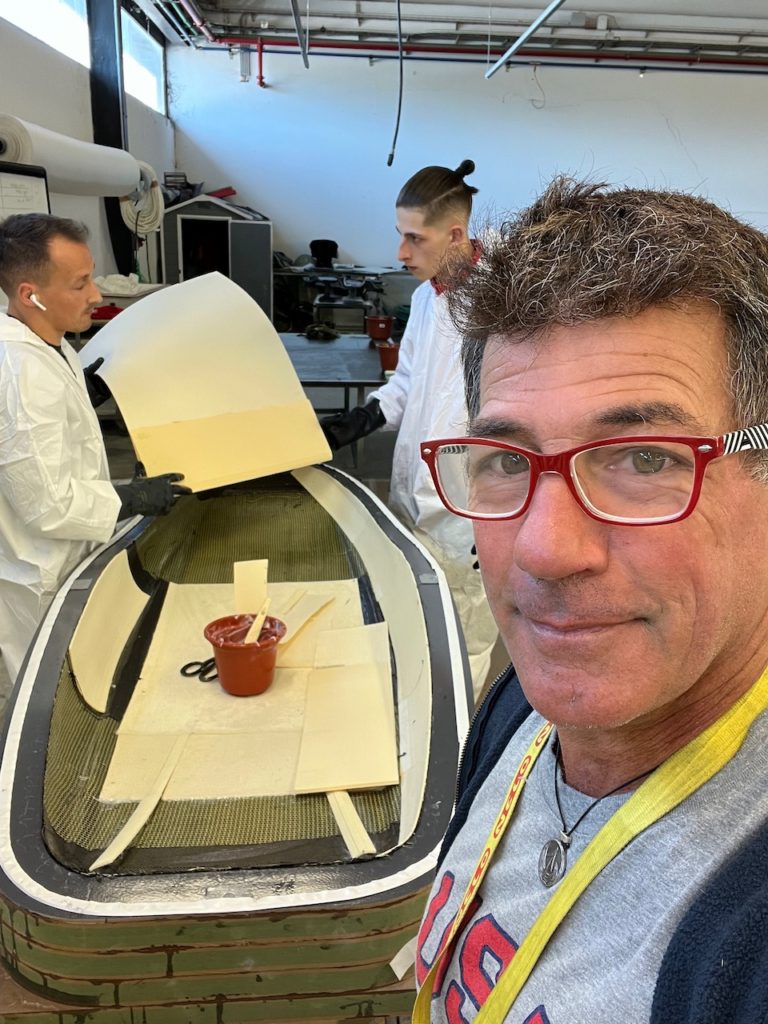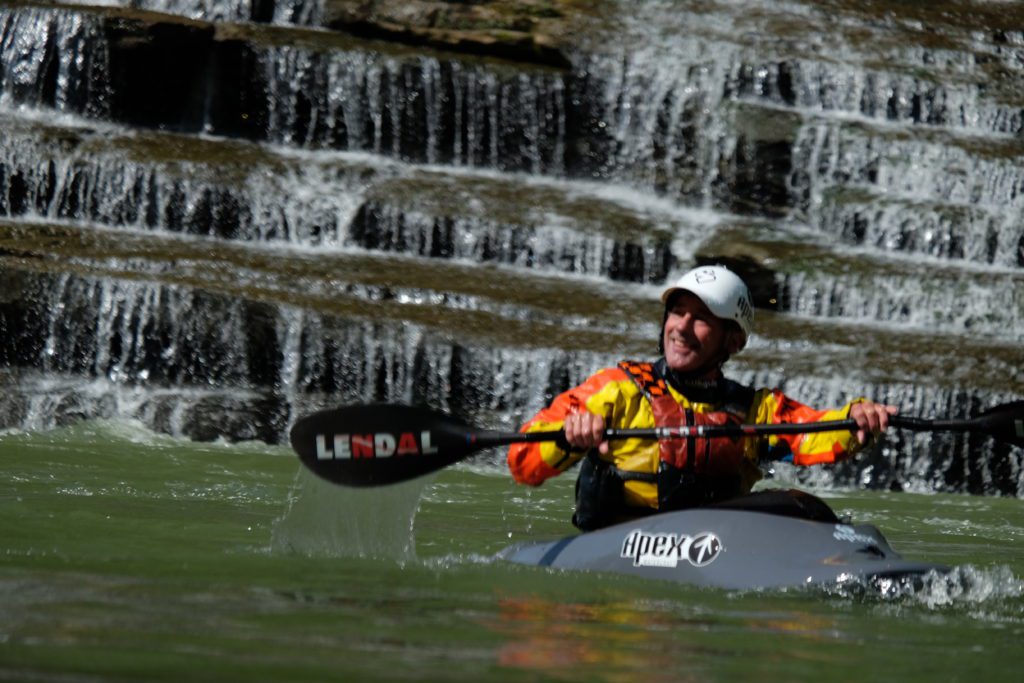Advance composites construction is now being used for everything from bicycles, to fighter jets. Only a few slalom and freestyle whitewater kayaks have been available to the general public, and most people wouldn’t know where or how to buy one if they did want one. I have wanted to deliver lightweight kayaks to my customers for a long time and I am finally doing it. Do to the lack of personal experience whitewater kayakers have with composite boats, this blog will provide you with the benefits, challenges, and how to determine if composite kayak construction is what you want in your next boat, or if you should just stick with plastic.

What are the benefits of a composite boat?
Let’s get the obvious, but overlooked out of the way. Weight. The #1 biggest advantage of an Apex Watercraft in composite, is how much lighter weight it is than another brand’s plastic boat of a similar design. The weight reduction is immediately felt when you pick the boat up. You can expect 40+% reduction. In many cases the boat is 1/2 of the weight of a plastic boat. There are three main benefits to the lighter weight.
- It is way easier to load, unload, and carry around. A smaller person will switch from hating, or being unable to carry their boat effectively, to having it be super easy and not a chore. The first time you pick one up you’ll smile ear to ear and be blown away with the difference.
- It performs much better on the water. Heavy boats take more energy to accelerate, turn, roll, or play. Once you paddle the lightweight composite boat, you’ll struggle to want to paddle a heavier boat. You will be spoiled and know what it is like and that is hard to come back from.
What are the challenges of a composite boat?
#1- they cost more to make, and will cost you more to buy. You can expect about double the cost of a plastic boat. The reasons for this are simple. Carbon fiber, Kevlar, foam core, epoxy, and the materials used in the molding process are all more expensive than plastic. Also, the total amount of labor time, and skills needed are dramatically greater than a plastic boat. In 1 hour you can mold a plastic boat and have the hull be ready to outfit. It takes about 48 hours to make a composite boat and have it ready to outfit. Some of that time is curing time, of course, but the mold is tied up for 16-18 hours before you can mold another boat, and then the boat is trimmed, the deck and hull joined, cockpit rim molded, trimmed and attached, outside seams, etc.. It is truly a craftsmanship job that requires a lot of training, skill, and experience before you can help the masters at work, and only a few can lead the charge.
#2- A composite boat requires maintenance that you will either need to learn, or pay for. While you may be able to go for years without any maintenance or repairs if you treat it gently and paddle deep water rivers, you may also need to do your first repair after the first day if things go wrong. Let’s be clear, a composite boat is not weak or easy to break, but the wrong type of rock with a hard enough hit and it will break. The good news about breaking a composite boat (usually a crack that is visible, but not catastrophic and often doesn’t leak, either), is that you can fix it easily with a bit of knowledge, and the right materials. If you keep a repair kit on hand, the typical repair job will take you 1 hour and will require 12 hours of cure time, and then from zero to 1 hour of clean up time. Most carbon fiber kayaks last longer than most plastic boats due to the ease of repair and the fact that plastic boats wear out easier due to the softer materials.

What Types of Rivers are good for composite boats and what are not?
Deeper rivers and creeks are clearly the best as your boat will spend more time in the water and less time on rocks. Composite boats slide well over most rocks, but the super grabby ones dig into the epoxy and will leave big scratches or gouges. For Freestyle kayaks, if you are slamming the bottom on loops every time, and you are slamming your stern on cartwheels all day long, you should paddle plastic. Don’t get me wrong, your composite Rebound can handle looping off of the rocks and hitting bottom, but if you do it enough times you’ll wear off the outside seams, and if you do it hard enough you’ll have to repair the boat eventually. This is where a plastic boat shines. Slamming the bottom over and over again and it will wear the ends down, but it takes a lot to break it. (yes, you can break your bow and stern on a plastic boat from hitting too many times or too hard). If you want the best performance and are only hitting occasionally, you’ll appreciate composite.
1/2 Slice or River Running/Creek boats– Paddling downriver in a composite boat is a joy. However, like a freestyle kayak, some rivers are better than others for it. A large percentage of creeks/river are ideal for composite boats such as: Any creek or river where you are mostly supported by water, and only glance off of rocks, or boof off of them and they are not super grabby will be low stress and high enjoyment in a composite boat. Any creek or river where you are hitting a lot of rocks whether you want to or not, and the rocks are sharp or grabby, is not ideal. Also “ELFing” in a composite boat isn’t ideal. (Extra Low Flow). If you are wheelchairing your way down the river, paddle plastic.
How to “let go” and truly enjoy paddling composite- A brand new composite Apex kayak has a mirror finish on it. It is a piece of art. For that reason, many people will struggle to scratch it. Please, don’t be that person. Scratches, especially on the hull, give it character and show that you are paddling it. I personally get into the water on the shore, and slide in. I try to find places that have smooth rocks, or sand, or grass/leaves, etc. so that I am not creating extra wear for no reason, but I don’t baby my boats. Once you decide that it is OK to scratch your boat, you’ll truly put it to use and have more fun in it. You will scratch it whether you want to or not anyhow, so please, let go, and just enjoy the performance, and stress less about the perfect finish.

A few more nuances and recommendations, and facts about composite boats:
- ” Carbon Fiber Kayak”- while the primary material in the Apex Watercraft kayaks is carbon fiber, there are other composite materials that are critical to making the kayak durable, stiff, and perform as you want it to. Kevlar, Foam Core, high impact epoxy, even some fiberglass can be found employeed to create the best total solution for what the kayak needs to do, what abuse it will take, and what each material brings to the table. Only carbon fiber and epoxy will make a terrible kayak. It is the right mix of materials, the right local reinforcements, the right thicknesses and locations of foam core, and the right method of resin introduction. Infusion or wet layup? Everyone is fired up on infusion, because it is newer, but for the lightest, strongest boat, using PVC foam core, wet lay up is the only choice. Each style of kayak has its own weaknesses and where it needs the most reinforcements. A freestyle kayak and a 1/2 slice will be reinforced in different areas, for example.
- A composite Freestyle kayak goes bigger, is more retentive, and much easier to complete moves. If you go to do a “blunt” for example, it will snap around much faster, and you’ll be backwards in a backsurf much quicker with less energy. When you get back into a plastic boat, it will feel like a chore to do the same move, due to the increase in swing weight. If you are used to a plastic boat, you can do it and not feel like it is difficult, but after some time in a lightweight boat, you’ll set your bar much higher and it will spoil you. The bigger air on waves comes from the stiffness of a composite boat. To be clear, not all composite boats are stiff if they are not made to be stiff. An Apex Watercraft Rebound has a stiff hull that will transfer the energy from the wave into the hull and lift you off the water. A less stiff hull (like a plastic boat) will flex when trying to take off and lose much of the energy the wave was putting into getting off the water. The same exact situation, technique, etc. will go bigger in a composite boat.
- I did forget to mention that you can make a heavy composite boat. More material, too much resin, heavy outfitting, etc. can create a composite boat that is as heavy as a plastic boat. Apex is making composite boats that are close to 1/2 of the weight of the lightest plastic boats in the same category and size. That can be done and produce strong and durable boats that perform way better than the same boat with added weight.
- SIZE of the paddler and Weight of the Boat– a 250 pound paddler will stress a kayak twice as much as a 125 pound paddler. Since the larger paddler also paddles a boat that has a higher surface area hull that needs more support, it provides another construction challenge to overcome. If the kayak made for a 125 pound paddler is 14 pounds, then the 250 pound paddler should have boat that is 28 pounds, plus the extra to support the wider/longer hull. Make it 30 pounds. Plastic boats have never done that, or at least I never did. A little kid’s boat was overbuilt and almost NEVER breaks, and an XL boat was underbuilt and was more likely to break. Ultimately, I feel that there is a middle ground that provides the 250 pound paddler a high performance kayak that will be durable enough for them to be confident, but not heavy like a plastic boat. This is what you can expect for the larger models.
- Spray Skirts and Apex composite boats: the cockpit rim on an Apex Watercraft is a flat rim that holds a skirt very well. Unlike the rounded plastic boat cockpits, where the skirt can be pulled around the corner easily and leak or come off, the sharp corner keeps the skirt in place. This means that you can use a larger skirt size and not worry about it coming off. This makes it easier to get on and easier to keep the boat dry.
- The Seat of an Apex Watercraft Composite boat: due to the fact that the boat is built to be self-supporting and stiff, the seat no longer has to act as a structural part of the boat. This opens up the opportunity to make a super comfortable/lightweight seat out of mini-cell foam. We designed a very contoured, soft seat, that provides better control, and all day comfort. Less weight, and optional seat size for different size butts. It is a little known fact that all plastic kayak seats of the major brands are designed to fit an overweight female butt. Wider, bigger radius curves to seat the biggest butt, that can be padded out with hip pads to keep smaller butt people from sliding around in the seat. The Apex seat is CNC Machined, meaning no mold made for the seat. Each seat is individually cut out of mini-cell foam following a CAD file design. I have created multiple seat shapes that fit a variety of butt shapes and sizes. Instead of “one size fits all”, you can choose one that best fits you for more comfort and control/performance.
Summary:
Owning and paddling a lightweight composite whitewater kayak is a joy. In 5 years, it will be the norm, not the exception, and Apex will lead the charge. Once you and your friends/family experience the performance and ease of moving around, as well as the beauty of them, it will purely be a function of if you can afford the extra cost, or if that cost is worth it. I would lower the price to match plastic, if I could, but that isn’t possible. There will always be a place for plastic. Since almost every whitewater or fishing company in the world makes a plastic boat, the biggest impact I could have on paddlers was to bring composites to them in the latest, highest performance designs. I am also looking forward to bringing plastic Apex Watercraft boats to you, as I want people who can’t afford a composite boat, or people who need a plastic boat to be able to paddle Apex. The Extreme Slalom rules require that the boats be plastic. The Ringer will be the favorite for the 2023 World Championships and the 2024 Olympics, in plastic. However, if you don’t have to use plastic, because you are not racing in ICF events- the composite version provides the best performance. I look forward to seeing you on the water!
Sincerely,
🙂
EJ


